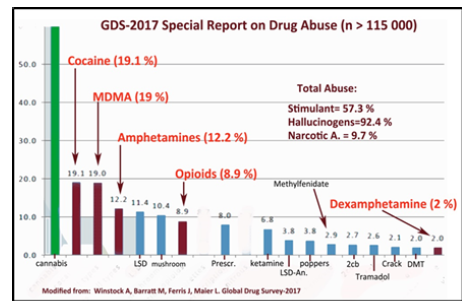A Schematic Overview of Addiction: Molecular Effects of Cocaine, Methamphetamine and Morphine on Limbic Neurons by Ümit Sayın H* in Forensic Science & Addiction Research_ International Journal of Forensic Sciences

Abstract
Abuse
of methamphetamine, cocaine and morphine is an increasing global problem.
According to 2018 UNODOC
report between 2012 and 2016, 151 millions of people used cannabis; 146
millions of people consumed cocaine; 275 millions of people used opioids and
opiates; 131 millions of people consumed amphetamines. According to another
Global Drug Survey-2017, the figures of addiction may be much worse than the
expected. People use cocaine and amphetamines because these drugs increase the
dopamine release in ventral tegmental area (VTA), nucleus accumbens (NA) and
prefrontal cortex, brain regions which take part in the reward-pleasure
circuitry. They also play major roles in the development of addiction. In the
review the mechanism of action of amphetamines, cocaine and morphine are
explained in a very clean schematic way; explaining why people get addicted to
these drugs. Cocaine binds strongly to the dopamine-reuptake transporter,
preventing the reuptake of dopamine into the nerve terminal. Because of this
blocking effect, dopamine remains at high concentrations in the synapse and
continues to affect adjacent neurons, producing the characteristic cocaine
“high”.
Activated
D1 receptor activates the PKA signaling pathway, and this pathway plays a
critical role in mediating the behavioral responses to cocaine administration.
Cocaine-induced neuroadaptations, including dopamine depletion, may underlie
craving and hedonic dysregulation. Acute administration of amphetamine induces
phosphorylation of cAMP response element-binding protein (CREB) and expression
of several immediate early genes (IEGs), such as c-fos. The IEGs is likely to
initiate downstream molecular events, which may have important roles in the
induction and maintenance of addictive states. Chronic exposure to amphetamine
induces a unique transcription factor delta FosB, which plays an essential role
in long-term adaptive changes in the brain. Morphine can cause indirect
excitation of VTA dopamine neurons by reducing inhibitory synaptic transmission
mediated by GABAergic neurons. The chronic use of morphine is characterized by
adaptive changes in neurons and neuronal communication; such adaptations (e.g.,
‘super-activation’ of adenylyl cyclase) must underlie altered behavior
associated with morphine dependence and withdrawal syndrome, as well as
drug-induced craving and relapse to drug use
https://crimsonpublishers.com/fsar/fulltext/FSAR.000599.php
Crimson
Publishers: https://crimsonpublishers.com/
For more articles in International Journal of Forensic Sciences,
Please click on below link: https://crimsonpublishers.com/fsar/



No comments:
Post a Comment